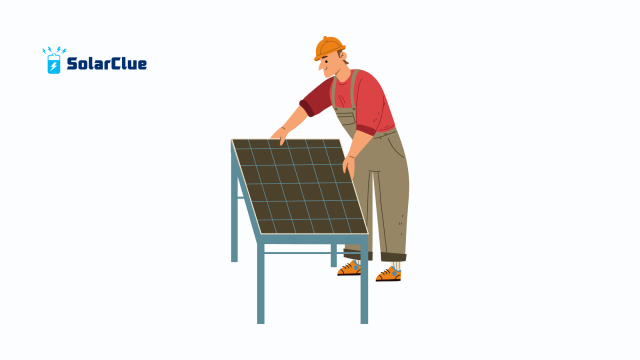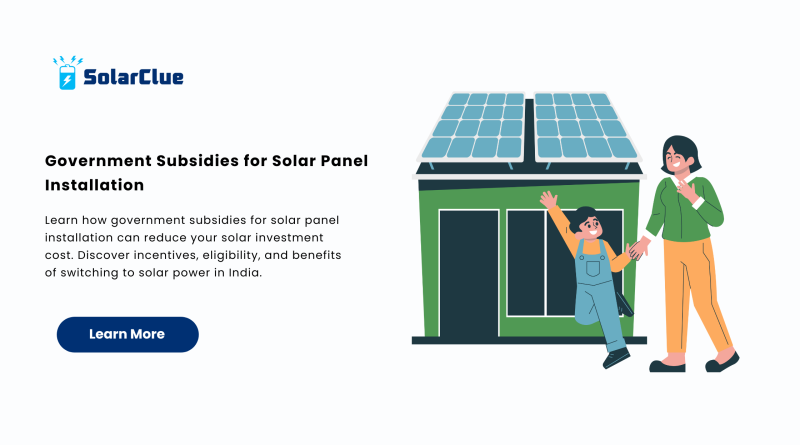Government Subsidies for Solar Panel Installation
Switching to solar energy is one of the smartest and most sustainable decisions homeowners and businesses can make today. With the rising demand for clean energy, the Indian government has stepped up efforts to promote solar panel installation through attractive incentives and subsidy schemes. These government subsidies for solar panel installation aim to make solar power more affordable, reduce carbon footprints, and boost energy independence.
In this blog, we’ll walk you through everything you need to know about solar panel subsidies in India, how to avail them, who is eligible, and the benefits you can enjoy with your new solar power system.
Table of Contents
- 1 Why the Government Supports Solar Power
- 2 Key Government Schemes for Solar Panel Subsidy
- 3 Eligibility Criteria for Solar Subsidy
- 4 How to Apply for Solar Subsidy in India
- 5 State-Wise Solar Subsidy Programs
- 6 Benefits of Government Subsidies for Solar Panels
- 7 Long-Term Financial Advantages
- 8 Common Challenges and How to Overcome Them
- 9 The Future of Solar Subsidies in India
- 10 FAQs
Why the Government Supports Solar Power
India is committed to achieving its renewable energy goals, with a strong focus on increasing solar power system adoption. The government wants to make clean energy accessible to all and reduce dependency on fossil fuels. By offering subsidies on solar panels, the government hopes to encourage households and institutions to invest in solar energy solutions, especially in urban and rural areas where electricity costs are high.
Key Government Schemes for Solar Panel Subsidy
1. PM Surya Ghar Muft Bijli Yojana
Launched in 2024, this is one of the most talked-about schemes providing solar panel for home installations with significant subsidies. Under this scheme:
-
Households can get up to ₹78,000 for a 3 kW system.
-
Free electricity of up to 300 units per month is promised.
-
Special loans and interest subvention are available for households that install rooftop solar panels.
2. MNRE Central Financial Assistance (CFA)
The Ministry of New and Renewable Energy (MNRE) offers Central Financial Assistance (CFA) for solar panel installation under the Rooftop Solar Programme Phase-II:
-
For residential sector:
-
40% subsidy for capacity up to 3 kW
-
20% subsidy for capacity above 3 kW and up to 10 kW
-
Common facilities in group housing societies get up to 20% subsidy
-
-
No subsidy for commercial or industrial use
Eligibility Criteria for Solar Subsidy
To qualify for government subsidies for solar panel installation, applicants must meet specific conditions:
-
The solar panel system must be installed by a vendor registered under MNRE or the state’s DISCOM-approved list.
-
It should be a grid-connected rooftop solar panel system.
-
Only domestic (residential) users are eligible for subsidy support.
-
The applicant must not have availed solar subsidy previously on the same premises.
How to Apply for Solar Subsidy in India
Applying for a solar panel subsidy is now easier, thanks to online platforms:
-
Visit the National Portal for Rooftop Solar
-
Register with your state’s electricity board.
-
Submit details about your location, connection number, and capacity of the system.
-
Select a registered vendor for installation.
-
Post-installation, the DISCOM will inspect the system and process your subsidy.
Once approved, the subsidy amount will be transferred directly to your bank account under DBT (Direct Benefit Transfer).

State-Wise Solar Subsidy Programs
Some Indian states offer additional solar panel installation incentives alongside central subsidies:
Maharashtra:
-
Offers special incentives under MEDA (Maharashtra Energy Development Agency).
-
Provides financial support for schools and panchayats.
Gujarat:
-
Known for the Surya Urja Rooftop Yojana.
-
Up to 40% subsidy for 1–3 kW systems.
Karnataka:
-
Actively promotes solar panel for home systems.
-
DISCOM-approved vendors handle installations with financial assistance.
Benefits of Government Subsidies for Solar Panels
Here’s why government subsidies for solar panel installation are a game-changer:
-
Reduces upfront cost: A system that costs ₹1.5 lakhs could be brought down to ₹90,000 or less with subsidies.
-
Faster ROI: With reduced capital investment and savings on electricity bills, payback can happen in 3–4 years.
-
Increases affordability for the middle class: Solar is no longer a luxury.
-
Boosts environmental sustainability: Lower carbon footprint and cleaner air.
-
Improves grid stability: Solar rooftops help reduce the load on the national grid.
Long-Term Financial Advantages
Even after availing the subsidy, the long-term benefits of owning a solar power system are massive. An average Indian household can save ₹1,000 to ₹2,500 monthly, depending on the system size and electricity consumption. In 20 years, this adds up to several lakhs in savings. Plus, a solar panel increases your property’s value, making it an intelligent investment.
Common Challenges and How to Overcome Them
While the government is doing its best, there are still a few challenges:
-
Lack of awareness about subsidy schemes
-
Unregistered or fraudulent vendors
-
Delays in disbursal of subsidies
To avoid these, always:
-
Use MNRE or DISCOM-approved installers
-
Monitor the process through official portals
-
Keep all installation documents and photos for submission
The Future of Solar Subsidies in India
India’s renewable energy mission is evolving, and so are its policies. The focus is on:
-
Making subsidies more inclusive for rural areas
-
Integrating battery storage subsidies in the near future
-
Streamlining the online application process
With the government’s strong push, solar is becoming a part of every Indian household’s future.
FAQs
Q1. Can I get a solar panel subsidy for commercial use?
No, subsidies under current MNRE schemes are limited to residential rooftop systems only.
Q2. Is there a subsidy for battery storage or hybrid systems?
Not yet under the central scheme, but upcoming policies may include battery incentives.
Q3. How long does it take to receive the subsidy amount?
Typically 30–90 days after installation and inspection by your DISCOM.
Q4. What happens if I don’t use an approved vendor?
You may become ineligible for the subsidy if the vendor isn’t registered with MNRE or DISCOM.
Q5. Can I upgrade my system later and still get a subsidy?
Subsidy is typically provided once per property. Adding capacity later may not be eligible for further incentives.
Ready to take the leap towards clean energy and save on electricity bills? Visit solarclue.com and blog.solarclue.com today—your journey to a solar-powered future starts here!


